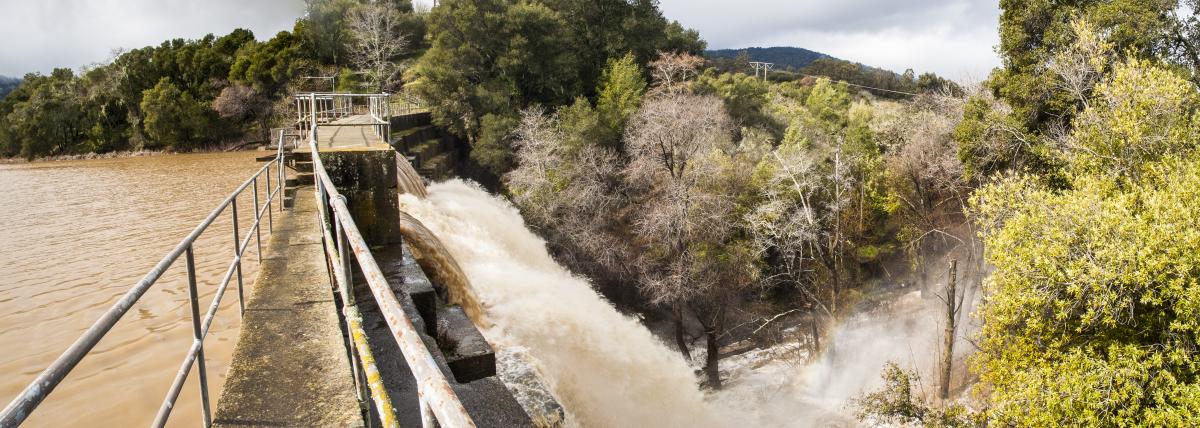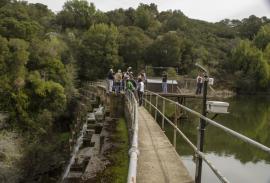Watershed Management
 Searsville Alternatives Study Steering Committee recommends adaptable approach to taking action on Searsville Dam and reservoir
Searsville Alternatives Study Steering Committee recommends adaptable approach to taking action on Searsville Dam and reservoir
One of the great assets of Jasper Ridge Biological Preserve is the opportunity to learn from ecological changes, whether they arise from natural or human activity.
One of the biggest challenges facing the preserve—what to do about Searsville Dam and reservoir—promises significant changes for Jasper Ridge and the San Francisquito Creek watershed in the coming decades.
This future will offer an exceptional chance to gain knowledge about large-scale ecological intervention and restoration. But it also poses obstacles and risks to the watershed as well as the preserve’s research, education, and conservation work.
To come up with a management plan that also protects and enhances Jasper Ridge’s academic mission and programs, Stanford University’s Searsville Alternatives Study extensively evaluated various options for handling the dam and reservoir, in cooperation with other watershed interests and authorities.
 Because there is no indisputable, completely predictable, or risk-free solution, the Steering Committee favored an adaptive and resilient approach that allows for adjustments when natural systems respond in unexpected and undesirable ways. The Committee published its recommendations for managing Stanford’s portion of the watershed in April 2015.
Because there is no indisputable, completely predictable, or risk-free solution, the Steering Committee favored an adaptive and resilient approach that allows for adjustments when natural systems respond in unexpected and undesirable ways. The Committee published its recommendations for managing Stanford’s portion of the watershed in April 2015.
Without intervention, sediment eroding from the Santa Cruz Mountains will completely fill the reservoir and overflow the dam—influencing downstream hydrologic behavior and potentially altering flooding dynamics. East Palo Alto, Menlo Park, and Palo Alto are largely built on the former alluvial fan, a type of floodplain, of San Francisquito Creek downstream of the century-old dam. Already, the reservoir has lost more than 90 percent of its original water storage capacity.
In addition to safeguarding Jasper Ridge operations and aims, the Steering Committee gave priority to:
- Addressing both accumulated and future sediment load, without increasing flooding risk (and exploring ideas to reduce risk).
- Contributing to the long-term sustainability of Stanford’s water supply in an era of drought and climate change.
- Supporting and enhancing the ecological health of the San Francisquito Creek watershed, with particular attention to species of conservation concern.
- Preserving important cultural resources, including archeological sites.
- Maintaining land use flexibility to support the university’s unknown future needs to achieve its mission.
- Focusing on fiscally feasible stewardship actions, and working with others on shared responsibilities.
Preferred Option
Of the many options studied, the Committee’s preferred alternative is passive flow management. The proposal calls for cutting a large opening at the base of the dam. This would drain the reservoir and restore Corte Madera Creek’s original flow pattern all the way to where it joins Bear Creek, some 500 meters below the dam, to form San Francisquito Creek.
Because the dam would no longer stockpile sediment from the upper watershed, this option only works with the collaboration of downstream agencies to prepare San Francisquito Creek infrastructure for renewed annual sediment flows, and some flushing of accumulated fine sediment from the reservoir to the bay. Much of the already-accumulated sediment could be stored in place, held by seepage walls that would also help preserve the artificially enlarged—but nonetheless rare and habitat-rich—freshwater marshes by the Searsville reservoir.
The plan also involves expanding the capacity of Stanford’s Felt Lake to replace Searsville’s water storage function.
The benefits of the dam-modification approach include:
- Creating a passage for fish, specifically threatened steelhead trout, through the opening.
- Providing a way to reduce peak flows downstream.
- Reducing the volume of dredging (only needed at the dam face) and sediment removal, drastically limiting the number of truck trips through local communities and the preserve.
- Preserving wetlands habitat and restoring riparian habitat.
- Retaining the ability to close the dam opening if hydrologic and sediment responses are inconsistent with what models have projected.
- Maintaining the possibility of eventually removing the dam if watershed responses are appropriate for that alternative.
- Nurturing San Francisco Bay wetlands with natural sediment flows.
- Conducting valuable research and generating knowledge about hard-to-predict sediment behavior, hydrologic responses, ecological intervention, and restoration.
To reach their recommendations, the Steering Committee considered technical studies provided by an expert engineering and environmental consulting team, plus contributions from an external advisory group representing community and resource agency perspectives.
The Committee members are some of Stanford’s most talented environmental faculty and senior administrators. They represent disciplinary expertise in the earth sciences, global ecology, hydrology, conservation biology, environmental engineering, environmental law, history, archaeology, risk management, and land-use change.
On several occasions throughout the four-year course of the study, the accrued information and analysis altered Jasper Ridge management’s views on which were the most resilient and beneficial alternatives. From the preserve’s perspective, the current plan appears to provide rich opportunities with limited disruptions to the preserve’s goals and mission.
The next steps are already underway: additional engineering and technical studies on the selected proposal, and important conversations with permitting agencies and downstream communities.
“Our highest mission needs to be assuring that future generations of scientists, conservationists, and students continue to benefit from this unique and complex place,” remarked Jasper Ridge Faculty Director and co-chair of the steering committee Chris Field, PhD ’81, in the preserve’s 2014 Annual Report.



